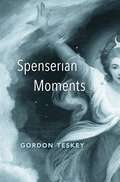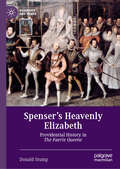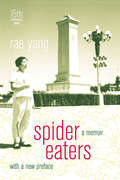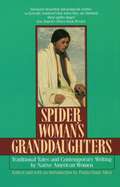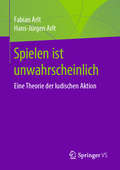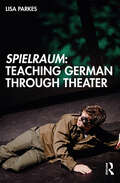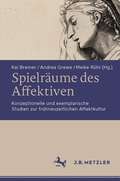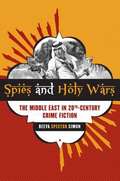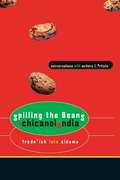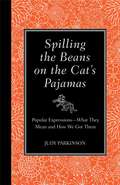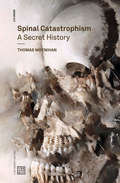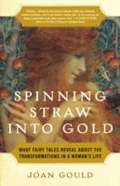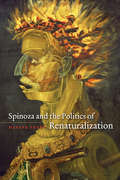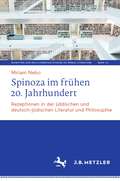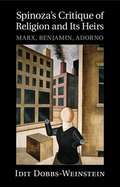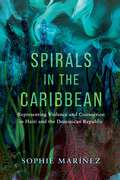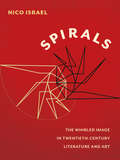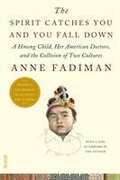- Table View
- List View
Spenserian Moments
by Gordon TeskeyGordon Teskey restores Edmund Spenser to prominence, revealing his epic The Faerie Queene as a grand, improvisatory project on human nature. Teskey compares Spenser to Milton, an avowed follower. While Milton’s rigid ideology is now stale, Spenser’s allegories remain vital, inviting new questions and visions, heralding a constantly changing future.
Spenser’s Famous Flight
by Patrick CheneyIn Spenser's famous Flight, Patrick Cheney challenges the received wisdom about the shape and goal of Spenser's literary career. He contends that Spenser's idea of a literary career is not strictly the convential Virgilian pattern of pastoral to epic, but a Christian revision of that pattern in light of Petrarch and the Reformation. Cheney demonstrates that, far from changing his mind about his career as a result of disillusionment, Spenser embarks upon and completes a daring progress that secures his status as an Orphic poet. In October, Spenser calls his idea of a literary career the 'famous flight. ' Both classical and Christian culture has authorized the myth of the winged poet as a primary myth of fame and glory. Cheney shows that throughout his poetry Spenser relies on an image of flight to accomplish his highest goal.
Spenser’s Heavenly Elizabeth: Providential History in The Faerie Queene (Queenship and Power)
by Donald StumpThis book reveals the queen behind Edmund Spenser’s The Faerie Queene. Placing Spenser’s epic poem in the context of the tumultuous sixteenth century, Donald Stump offers a groundbreaking reading of the poem as an allegory of Elizabeth I’s life. By narrating the loves and wars of an Arthurian realm that mirrors Elizabethan England, Spenser explores the crises that shaped Elizabeth’s reign: her break with the pope to create a reformed English Church, her standoff with Mary, Queen of Scots, offensives against Irish rebels and Spanish troops, confrontations with assassins and foreign invaders, and the apocalyptic expectations of the English people in a time of national transformation. Brilliantly reconciling moral and historicist readings, this volume offers a major new interpretation of The Faerie Queene.
Spider Eaters
by Rae YangSpider Eaters is at once a moving personal story, a fascinating family history, and a unique chronicle of political upheaval told by a Chinese woman who came of age during the turbulent years of the Cultural Revolution. With stunning honesty and a lively, sly humor, Rae Yang records her life from her early years as the daughter of Chinese diplomats in Switzerland, to her girlhood at an elite middle school in Beijing, to her adolescent experience as a Red Guard and later as a laborer on a pig farm in the remote northern wilderness. She tells of her eventual disillusionment with the Maoist revolution, how remorse and despair nearly drove her to suicide, and how she struggled to make sense of conflicting events that often blurred the line between victim and victimizer, aristocrat and peasant, communist and counter-revolutionary. Moving gracefully between past and present, dream and reality, the author artfully conveys the vast complexity of life in China as well as the richness, confusion, and magic of her own inner life and struggle. Much of the power of the narrative derives from Yang's multi-generational, cross-class perspective. She invokes the myths, legends, folklore, and local customs that surrounded her and brings to life the many people who were instrumental in her life: her nanny, a poor woman who raised her from a baby and whose character is conveyed through the bedtime tales she spins; her father; and her beloved grandmother, who died as a result of the political persecution she suffered. Spanning the years from 1950 to 1980, Rae Yang's story is evocative, complex, and told with striking candor. It is one of the most immediate and engaging narratives of life in post-1949 China.
Spider Woman's Granddaughters
by Paula Gunn AllenThese 24 compelling and bleakly evocative narratives compiled by Allen, a professor of Native American studies at the University of California, all stress the theme of loss: loss of identity, loss of culture, loss of personal meaning. By juxtaposing traditional stories with contemporary tales, Allen allows readers to see how the same themes, values and perceptions have endured through the centuries, "testaments to cultural persistence, to a vision and a spiritual reality that will not die." Echoes of the traditional "Oshkikwe's Baby," about an old witch who steals babies, can be found in two stories. In Louise Erdrich's "American Horse," a white social worker separates a boy from his mother for his own "good," to the anguish of mother and son.- Publishers Weekly
Spielen ist unwahrscheinlich: Eine Theorie der ludischen Aktion
by Hans-Jürgen Arlt Fabian ArltBegründet und entfaltet wird ein Begriff des Spiels, der sich um Lockungen und Drohungen des Unerwarteten dreht. Das Autorenduo ordnet seine Theorie der ludischen Aktion in klassische Konzepte des Spiels ein sowie in den aktuellen Diskurs der Game Studies. Die phänomenale Mannigfaltigkeit des Spiels wird in historischer Perspektive skizziert und in systematischer Weise gegliedert. Die Autoren erläutern medientechnische und kommunikative Voraussetzungen des Booms der Computerspiele und reflektieren die Diskussion über Eskalationen ludischer Gewalt. Kritisch ausgeleuchtet werden Instrumentalisierungen des Spiels, die sich unter dem Stichwort Gamification wachsender Beliebtheit erfreuen. Die auffällige Inflation der Spielmetapher wird in Zusammenhang gebracht mit ludischen Anmutungen in den sozialen Strukturen der modernen und digitalen Gesellschaft.Fabian Arlt, M. A., hat Medienmanagement studiert und promoviert im Studiengang Gesellschafts- und Wirtschaftskommunikation der Universität der Künste (UdK) in Berlin.Prof. Dr. Hans-Jürgen Arlt ist Sozialwissenschaftler und Publizist, er lehrt am Institut für Theorie und Praxis der Kommunikation der Universität der Künste (UdK) in Berlin.
Spielraum: Teaching German through Theater
by Lisa ParkesSpielraum: Teaching German through Theater is a sourcebook and guide for teaching German language and culture, as well as social, cross-cultural, and multi-ethnic tensions, through dramatic texts. This book presents a range of theoretical and practical resources for the growing number of teachers who wish to integrate drama and theater into their foreign-language curriculum. As such, it may be adopted as a flexible tool for teachers seeking ways to reinvigorate their language classrooms through drama pedagogy; to connect language study to the study of literature and culture; to inspire curricular rejuvenation; or to embark on full-scale theater productions. Focusing on specific dramatic works from the rich German-speaking tradition, each chapter introduces unique approaches to a play, theme, and genre, while also taking into account practical issues of performance.
Spielräume des Affektiven: Konzeptionelle und exemplarische Studien zur frühneuzeitlichen Affektkultur
by Kai Bremer Andrea Grewe Meike RühlDer Band eröffnet interdisziplinäre Zugriffe auf die Dynamik affektiver Normen und Normierungen in der Frühen Neuzeit. Welchen Normen war affektives Handeln unterworfen? Gab es geschlechterspezifische Unterschiede, die die Spielräume des Affektiven und die Möglichkeiten, diese zu verändern, prägten? Wie wurden diese Spielräume gesellschaftlich konnotiert und in den Künsten thematisiert? Diese und verwandte Fragen werden konzeptionell und exemplarisch mit Beiträgen aus Theologie, Philosophie, Literatur-, Musik-, Kunst- und Geschichtswissenschaft behandelt.
Spies and Holy Wars: The Middle East in 20th-Century Crime Fiction
by Simon Reeva SpectorIlluminating a powerful intersection between popular culture and global politics, Spies and Holy Wars draws on a sampling of more than eight hundred British and American thrillers that are propelled by the theme of jihad--an Islamic holy war or crusade against the West. Published over the past century, the books in this expansive study encompass spy novels and crime fiction, illustrating new connections between these genres and Western imperialism. Demonstrating the social implications of the popularity of such books, Reeva Spector Simon covers how the Middle Eastern villain evolved from being the malleable victim before World War II to the international, techno-savvy figure in today's crime novels. She explores the impact of James Bond, pulp fiction, and comic books and also analyzes the ways in which world events shaped the genre, particularly in recent years. Worldwide terrorism and economic domination prevail as the most common sources of narrative tension in these works, while military "tech novels" restored the prestige of the American hero in the wake of post-Vietnam skepticism. Moving beyond stereotypes, Simon examines the relationships between publishing trends, political trends and popular culture at large--giving voice to the previously unexamined truths that emerge from these provocative page-turners.
Spilling Ink: A Young Writer's Handbook
by Anne Mazer Ellen Potter Matt PhelanLearn How To Write Like The Experts, From The Experts. Practical advice in a perfect package for young aspiring writers. After receiving letters from fans asking for writing advice, accomplished authors Anne Mazer and Ellen Potter joined together to create this guidebook for young writers. The authors mix inspirational anecdotes with practical guidance on how to find a voice, develop characters and plot, make revisions, and overcome writer's block. Fun writing prompts will help young writers jump-start their own projects, and encouragement throughout will keep them at work.
Spilling Ink: A Young Writer's Handbook
by Anne Mazer Ellen PotterLEARN HOW TO WRITE LIKE THE EXPERTS, FROM THE EXPERTS. In Spilling Ink: A Young Writer's Handbook, you'll find practical advice in a perfect package for young aspiring writers.After receiving letters from fans asking for writing advice,accomplished authors Anne Mazer and Ellen Potter joined together to create this guidebook for young writers. The authors mix inspirational anecdotes with practical guidance on how to find a voice, develop characters and plot,make revisions, and overcome writer's block. Fun writing prompts will help young writers jump-start their own projects, and encouragement throughout will keep them at work.
Spilling the Beans in Chicanolandia: Conversations with Writers and Artists
by Frederick Luis AldamaSince the 1980s, a prolific "second wave" of Chicano/a writers and artists has tremendously expanded the range of genres and subject matter in Chicano/a literature and art. Building on the pioneering work of their predecessors, whose artistic creations were often tied to political activism and the civil rights struggle, today's Chicano/a writers and artists feel free to focus as much on the aesthetic quality of their work as on its social content. <P><P>They use novels, short stories, poetry, drama, documentary films, and comic books to shape the raw materials of life into art objects that cause us to participate empathetically in an increasingly complex Chicano/a identity and experience. <P> This book presents far-ranging interviews with twenty-one "second wave" Chicano/a poets, fiction writers, dramatists, documentary filmmakers, and playwrights. Some are mainstream, widely recognized creators, while others work from the margins because of their sexual orientations or their controversial positions. Frederick Luis Aldama draws out the artists and authors on both the aesthetic and the sociopolitical concerns that animate their work. Their conversations delve into such areas as how the artists' or writers' life experiences have molded their work, why they choose to work in certain genres and how they have transformed them, what it means to be Chicano/a in today's pluralistic society, and how Chicano/a identity influences and is influenced by contact with ethnic and racial identities from around the world.
Spilling the Beans on the Cat's Pajamas
by Judy Parkinson"Make no bones about it"--here's a "grand slam" for anyone seeking the meanings of catch phrases and quotes that enrich our everyday speech. It "rounds up the usual suspects"--hundreds of expressions that keep our language flourishing--and makes them easy to find in an A-to-Z format. If "all goes according to plan," you'll soon know: The expressions "all that glitters is not gold" and "apple of the eye" have each been in use for more than 1,000 years. "To bark up the wrong tree" comes from the sport of raccoon hunting. "The big enchilada" was used to describe someone on the infamous Watergate tapes. "Flavor of the month" was a generic advertising phrase of the mid-1940s used to describe new ice cream flavors. "Baker's dozen" is 13, one more than the standard dozen, and goes back to medieval times, when Henry III called for the severe punishment of any bakers caught shortchanging customers. English bakers developed the habit of including an extra loaf of bread when asked for a dozen to ensure that they wouldn't be condemned. "Drop of a hat" alludes to the frontier practice of dropping a hat as a signal for a boxing or wrestling match to begin, usually the only formality observed. "Sleep tight" dates back to when beds were made of rope and straw. Before going to sleep at night, people would have to pull the ropes tight, as they would have loosened during the course of the previous night's sleep. With this clever book on hand, you'll never have to "throw in the towel" during a battle of wits. Make this and all of the Blackboard Books(tm) a permanent fixture on your shelf, and you'll have instant access to a breadth of knowledge. Whether you need homework help or want to win that trivia game, this series is the trusted source for fun facts.
Spinal Catastrophism: A Secret History
by Thomas MoynihanThe historical continuity of spinal catastrophism, traced across multiform encounters between philosophy, psychology, biology, and geology. Drawing on cryptic intimations in the work of J. G. Ballard, Georges Bataille, William Burroughs, André Leroi-Gourhan, Elaine Morgan, and Friedrich Nietzsche, in the late twentieth century Daniel Barker formulated the axioms of spinal catastrophism: If human morphology, upright posture, and the possibility of language are the ramified accidents of natural history, then psychic ailments are ultimately afflictions of the spine, which itself is a scale model of biogenetic trauma, a portable map of the catastrophic events that shaped that atrocity exhibition of evolutionary traumata, the sick orthograde talking mammal. Tracing its provenance through the biological notions of phylogeny and “organic memory” that fueled early psychoanalysis, back into idealism, nature philosophy, and romanticism, and across multiform encounters between philosophy, psychology, biology, and geology, Thomas Moynihan reveals the historical continuity of spinal catastrophism. From psychoanalysis and myth to geology and neuroanatomy, from bioanalysis to chronopathy, from spinal colonies of proto-minds to the retroparasitism of the CNS, from “railway spine” to Elizabeth Taylor's lost gill-slits, this extravagantly comprehensive philosophical adventure uses the spinal cord as a guiding thread to rediscover forgotten pathways in modern thought. Moynihan demonstrates that, far from being an fanciful notion rendered obsolete by advances in biology, spinal catastrophism dramatizes fundamental philosophical problematics of time, identity, continuity, and the transcendental that remain central to any attempt to reconcile human experience with natural history.
Spine Poems: An Eclectic Collection of Found Verse for Book Lovers
by Annette Dauphin SimonA charming, clever, and original collection of more than 100 spine poems–a popular form of found poetry composed by arranging book spines—illustrated with 110 full-color photographs.Easy to create and share online, spine poems—also known as collage poems or centos—have become a fun and popular way of writing poetry. Spine Poems is a delightful, illustrated collection of more than 100 spine poems that range from hilarious to heart-rending to profound.Award-winning creative director and former bookseller Annette Dauphin Simon has arranged the poems in categories that resemble those found in a bookstore: Art, Biography and Memoir, Business, Cooking, Home and Garden, Music, Parenting, Philosophy, Politics, Pop Culture, Science Fiction and Fantasy, and True Crime. Each poem pulls from a wide variety of book genres and ranges from the short and quippy to lengthier and poignant.Ridiculous / Hilarious / Terrible / Cool Other Words for Home Elisha Cooper / Jasmine WargaEek!My HeartIs WasTorpedoedHundred PercentWonderstruckDidn’t See That ComingRestartJulie Larios and Julie Paschkis / Corinna Luyken / Deborah Freedman / Deborah Heiligman /Karen Romano Young / Brian Selznick / Rachel Hollis / Gordon KormanEvery poem is visually captured in a color photograph of stacked book spines taken by the author and is presented in a text version on the opposite page. Each spread also includes a list of the authors and artists whose titles make up the poem, and features quotes, fun facts, and other related literary and popular culture miscellany.Spine Poems is a wonderful keepsake and gift book for all lovers of words, books, and poetry.
Spinning Straw into Gold: What Fairy Tales Reveal About the Transformations in a Woman's Life
by Joan GouldWhat's your favorite fairy tale? Whether it's Cinderella, Beauty and the Beast, Hansel and Gretel or another story, your answer reveals something significant about you, your experiences, and your soul. In this penetrating book, Joan Gould brings to the surface the hidden meanings in fairy tales and myths, and illuminates what they can tell you about the stages in your own life. As Gould explores the transformations that women go through from youth to old age--leaving home and mother, the first experience of sexuality, the surprising ambivalence of marriage, the spiritual work required by menopause and aging--her keen observations will enrich your awareness of your inner life. Full of archetypal figures known to us all, Spinning Straw into Gold also includes stories from the lives of ordinary women that clarify the insights to be gained from the beloved tales that have been handed down from one generation to the next.
Spinoza and the Politics of Renaturalization
by Hasana SharpThere have been many Spinozas over the centuries: atheist, romantic pantheist, great thinker of the multitude, advocate of the liberated individual, and rigorous rationalist. The common thread connecting all of these clashing perspectives is Spinoza’s naturalism, the idea that humanity is part of nature, not above it. In this sophisticated new interpretation of Spinoza’s iconoclastic philosophy, Hasana Sharp draws on his uncompromising naturalism to rethink human agency, ethics, and political practice. Sharp uses Spinoza to outline a practical wisdom of “renaturalization,” showing how ideas, actions, and institutions are never merely products of human intention or design, but outcomes of the complex relationships among natural forces beyond our control. This lack of a metaphysical or moral division between humanity and the rest of nature, Sharp contends, can provide the basis for an ethical and political practice free from the tendency to view ourselves as either gods or beasts. Sharp’s groundbreaking argument critically engages with important contemporary thinkers—including deep ecologists, feminists, and race and critical theorists—making Spinoza and the Politics of Renaturalization vital for a wide range of scholars.
Spinoza im frühen 20. Jahrhundert: Rezeptionen in der jiddischen und deutsch-jüdischen Literatur und Philosophie (Schriften zur Weltliteratur/Studies on World Literature #14)
by Miriam NeboDie breite jüdische Spinoza-Rezeption hatte mit Moses Mendelssohn begonnen und fand in Deutschland im Jahr 1932 mit dem Spinoza-Jubiläum ein Ende. Die jüdische Auseinandersetzung ist Teil der gesamten deutschsprachigen Spinoza-Rezeption, die im 19. Jahrhundert ihren Höhepunkt hatte und zu der neben philosophischen auch literarische Rezeptionen gehörten. Am Ende des 19. Jahrhunderts setzte eine jiddische Spinoza-Rezeption ein. In der Zwischenkriegszeit entstanden eine Reihe von jiddischen Texten, die die Person Baruch Spinozas und seine Theorie thematisierten. Das Buch widmet sich der Untersuchung der Spinoza-Texte von Yankev Shatzky, Melech Ravitch, Avrom Koralnik, Avrom Sutzkever, H. Leivick und Yoysef Tunkler. Ihre Spinoza-Rezeptionen werden mit denen einiger deutsch-jüdischer Autoren und Autorinnen verglichen. Die Analysen der Abhandlung stehen in einem literaturwissenschaftlich-komparatistischen und jiddistischen Kontext, zu dem philosophisch orientierte Perspektiven hinzutreten. Zudem bietet das Buch eine kompakte Darstellung des Rezeptionsthemas ab 1670 (u.a. zu Goethe, Hölderlin, Heine).
Spinoza's Critique of Religion and Its Heirs
by Idit Dobbs-WeinsteinSpinoza's heritage has been occluded by his incorporation into the single, western, philosophical canon formed and enforced by theologico-political condemnation, and his heritage is further occluded by controversies whose secular garb shields their religious origins. By situating Spinoza's thought in a materialist Aristotelian tradition, this book sheds new light on those who inherit Spinoza's thought and its consequences materially and historically rather than metaphysically. By focusing on Marx, Benjamin, and Adorno, Idit Dobbs-Weinstein explores the manner in which Spinoza's radical critique of religion shapes materialist critiques of the philosophy of history. Dobbs-Weinstein argues that two radically opposed notions of temporality and history are at stake for these thinkers, an onto-theological future-oriented one and a political one oriented to the past for the sake of the present or, more precisely, for the sake of actively resisting the persistent barbarism at the heart of culture.
Spinoza's Critique of Religion and Its Heirs: Marx, Benjamin, Adorno
by Idit Dobbs-WeinsteinBy focusing on Marx, Benjamin, and Adorno, Idit Dobbs-Weinstein explores the manner in which Spinoza's radical critique of religion shapes materialist critiques of the philosophy of history.
Spinoza's Ethics
by Benedictus de SpinozaAn authoritative edition of George Eliot's elegant translation of Spinoza's greatest philosophical workIn 1856, Marian Evans completed her translation of Benedict de Spinoza's Ethics while living in Berlin with the philosopher and critic George Henry Lewes. This would have become the first edition of Spinoza's controversial masterpiece in English, but the translation remained unpublished because of a disagreement between Lewes and the publisher. Later that year, Evans turned to fiction writing, and by 1859 she had published her first novel under the pseudonym George Eliot. This splendid edition makes Eliot's translation of the Ethics available to today's readers while also tracing Eliot's deep engagement with Spinoza both before and after she wrote the novels that established her as one of English literature's greatest writers.Clare Carlisle's introduction places the Ethics in its seventeenth-century context and explains its key philosophical claims. She discusses George Eliot's intellectual formation, her interest in Spinoza, the circumstances of her translation of the Ethics, and the influence of Spinoza's ideas on her literary work. Carlisle shows how Eliot drew on Spinoza's radical insights on religion, ethics, and human emotions, and brings to light surprising affinities between Spinoza's austere philosophy and the rich fictional worlds of Eliot's novels.This authoritative edition demonstrates why George Eliot's translation remains one of the most compelling and philosophically astute renderings of Spinoza's Latin text. It includes notes that indicate Eliot's amendments to her manuscript and that discuss her translation decisions alongside more recent English editions.
Spirals in the Caribbean: Representing Violence and Connection in Haiti and the Dominican Republic
by Sophie MaríñezAn in-depth analysis of literary and cultural productions from Haiti and the Dominican Republic and their diasporasSpirals in the Caribbean responds to key questions elicited by the human rights crisis accelerated in 2013 by the Dominican Constitutional Court’s Ruling 168-13, which denationalized hundreds of thousands of Dominicans of Haitian descent. Spirals details how a paradigm of permanent conflict between the two nations has its roots in reactions to the Haitian Revolution—a conflict between slavers and freedom-seekers—contests over which have been transmitted over generations, repeating with a difference. Anti-Haitian nationalist rhetoric hides this long trajectory. Through the framework of the Spiral, a concept at the core of a Haitian literary aesthetic developed in the 1960s called Spiralism, Sophie Maríñez explores representations of colonial, imperial, and national-era violence. She takes as evidence legislation, private and official letters, oral traditions, collective memories, Afro-indigenous spiritual and musical practices, and works of fiction, plays, and poetry produced across the island and its diasporas from 1791 to 2002.With its emphases on folk tales, responses to the 1937 genocide, the Constitution of the Dominican Republic, Afro-indigenous collective memories, and lesser-known literary works on the genocide of indigenous populations in the Caribbean, Spirals in the Caribbean will attract students, scholars, and general readers alike.
Spirals: The Whirled Image in Twentieth-Century Literature and Art (Modernist Latitudes)
by Nico IsraelIn this elegantly written and beautifully illustrated book, Nico Israel reveals how spirals are at the heart of the most significant literature and visual art of the twentieth century. Juxtaposing the work of writers and artists—including W. B. Yeats and Vladimir Tatlin, James Joyce and Marcel Duchamp, and Samuel Beckett and Robert Smithson—he argues that spirals provide a crucial frame for understanding the mutual involvement of modernity, history, and geopolitics, complicating the spatio-temporal logic of literary and artistic genres and of scholarly disciplines. The book takes the spiral not only as its topic but as its method. Drawing on the writings of Walter Benjamin and Alain Badiou, Israel theorizes a way of reading spirals, responding to their dual-directionality as well as their affective power. The sensations associated with spirals––flying, falling, drowning, being smothered—reflect the anxieties of limits tested or breached, and Israel charts these limits as they widen from the local to the global and recoil back. Chapters mix literary and art history to explore 'pataphysics, Futurism, Vorticism, Dada and Surrealism, "Concentrisme," minimalism, and entropic earth art; a coda considers the work of novelist W. G. Sebald and contemporary artist William Kentridge. In Spirals, Israel offers a refreshingly original approach to the history of modernism and its aftermaths, one that gives modernist studies, comparative literature, and art criticism an important new spin.
Spirit Catches You and You Fall Down: A Hmong Child, Her American Doctors, and the Collision of Two Cultures (FSG Classics)
by Anne FadimanWith a new Afterword from the author…Winner of the National Book Critics Circle Award for Nonfiction. <p><p> This book explores the clash between a small county hospital in California and a refugee family from Laos over the care of Lia Lee, a Hmong child diagnosed with severe epilepsy. <p><p> Lia's parents and her doctors both wanted what was best for Lia, but the lack of understanding between them led to tragedy. Winner of the National Book Critics Circle Award for Nonfiction, the Los Angeles Times Book Prize for Current Interest, and the Salon Book Award, Anne Fadiman's compassionate account of this cultural impasse is literary journalism at its finest.
